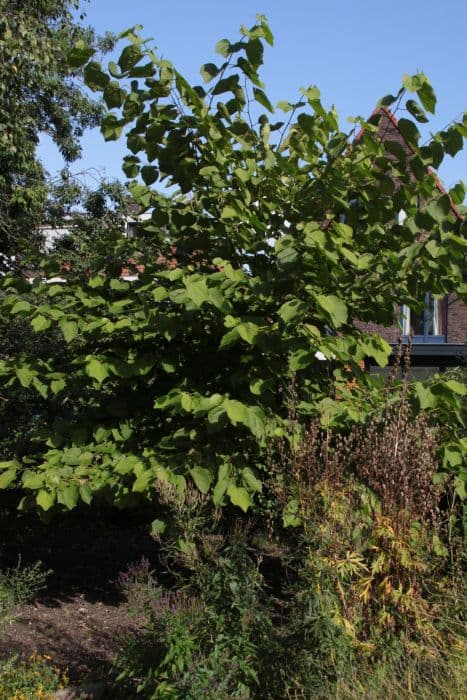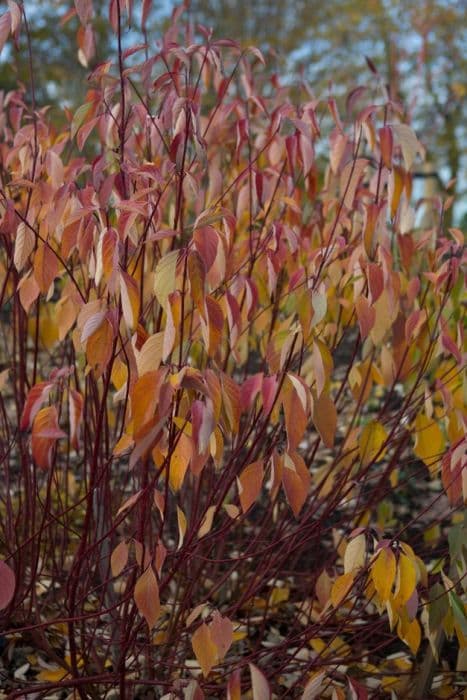Red Osier Dogwood Cornus sericea 'Hedgerows Gold' (v)

ABOUT
The Cornus sericea 'Hedgerows Gold', commonly known as the Red Twig Dogwood 'Hedgerows Gold', is a visually striking shrub. Its most remarkable feature is the vibrant red stems that provide exceptional winter interest, especially striking against a snowy backdrop. During the growing season, its foliage captivates with a combination of green and gold. The leaves are variegated, primarily green in the center with a broad, golden-yellow margin that illuminates the shrub in the landscape. In the fall, the leaves may take on warm shades of orange and red before they drop, revealing the red stems. Flowering in late spring to early summer, the Red Twig Dogwood 'Hedgerows Gold' presents clusters of small, creamy white flowers, which attract butterflies and other pollinators. These can develop into white berries that stand out against the foliage and stems, offering additional interest and also providing a food source for birds. The overall impression of the Red Twig Dogwood 'Hedgerows Gold' is of a multi-seasonal plant that provides a variety of colors and textures throughout the year, making it a valuable addition to any garden for its ornamental appeal.
About this plant
 Names
NamesFamily
Cornaceae.
Synonyms
Red Osier Dogwood, Red Twig Dogwood, Western Dogwood, American Dogwood, Creek Dogwood, Red-rood, Redstem Dogwood, Red Willow, Redstem Cornus, Red Brush, Red Sticks, Cornus Alba 'Hedgerows Gold'.
Common names
Cornus sericea 'Hedgerows Gold' (v).
 Toxicity
ToxicityTo humans
The plant commonly known as Red Osier Dogwood (Cornus sericea 'Hedgerows Gold') is not known to be toxic to humans. It does not typically cause poisoning and is not considered dangerous if ingested in small quantities. However, as with many plants, individual sensitivities can occur, and it is generally advisable to avoid consuming parts of ornamental plants due to the potential risk of stomach upset or other mild gastrointestinal discomfort.
To pets
The Red Osier Dogwood (Cornus sericea 'Hedgerows Gold') is generally considered to be non-toxic to pets. This plant does not commonly cause symptoms of poisoning in animals. However, ingestion of plant material may potentially cause mild gastrointestinal upset, such as vomiting or diarrhea in some pets. It is still best to prevent pets from chewing on ornamental plants as individual reactions may vary.
 Characteristics
CharacteristicsLife cycle
Perennials
Foliage type
Deciduous
Color of leaves
Variegated
Flower color
White
Height
6 feet (1.83 meters)
Spread
8 feet (2.44 meters)
Plant type
Shrub
Hardiness zones
3
Native area
North America
Benefits
 General Benefits
General Benefits- Attracts Wildlife: Cornus sericea 'Hedgerows Gold' provides shelter and food for birds, beneficial insects, and other wildlife.
- Ornamental Value: It has variegated foliage and bright red stems that add visual interest to the landscape throughout the seasons.
- Erosion Control: Its dense root system can help stabilize soil and prevent erosion, especially on slopes or in riparian areas.
- Low Maintenance: Once established, it requires minimal care, making it suitable for low-maintenance gardens and landscaping.
- Adaptable: It is adaptable to a range of soil types and conditions, though it prefers moist, well-drained soils.
- Tolerates Wet Conditions: The plant can tolerate and even thrive in wetter soil conditions, making it suitable for rain gardens or areas with poor drainage.
- Seasonal Interest: It provides year-round interest with its foliage, summer flowers, fall color, and winter stems.
- Native Plant Benefits: As a native plant, it supports local ecosystems and is likely to be more pest and disease resistant in its native range.
 Medical Properties
Medical Properties- This plant is not used for medical purposes.
 Air-purifying Qualities
Air-purifying QualitiesThis plant is not specifically known for air purifying qualities.
 Other Uses
Other Uses- Wildlife Shelter: Red osier dogwood provides cover and nesting sites for birds and small mammals due to its dense branching structure.
- Natural Dyes: The bark of red osier dogwood can be used to produce a range of natural dyes for textiles, yielding colors from reddish to tan shades.
- Water Erosion Control: Its root system helps stabilize riverbanks and areas prone to water erosion, making it beneficial for riparian restoration projects.
- Ornamental Twigs: The bright red-colored twigs can be harvested and used in floral arrangements or as decorative elements in winter gardens.
- Insect Breeding: Some butterfly and moth species use red osier dogwood as a host plant for their larvae, contributing to local biodiversity.
- Landscape Design: The variegated leaves are ideal for adding visual interest and contrast in landscape designs, especially during the non-flowering season.
- Educational Tool: As a native plant, it can be used in educational programs to teach about indigenous flora and fauna and their relationships.
- Fishing Rods: Historically, the straight, flexible twigs were used by some indigenous peoples to make traditional fishing rods.
- Photography Backdrop: The plant's vivid stems and lush foliage serve as an attractive background for wildlife and nature photography.
- Winter Interest: This variety of red osier dogwood is especially valuable for garden interest during the winter months when other plants have lost their leaves.
Interesting Facts
 Feng Shui
Feng ShuiRed Osier Dogwood is not used in Feng Shui practice.
 Zodiac Sign Compitability
Zodiac Sign CompitabilityRed Osier Dogwood is not used in astrology practice.
 Plant Symbolism
Plant Symbolism- Stability and Hope: Cornus sericea, commonly known as Red Osier Dogwood, often represents stability and hope due to its hardy nature and the way it remains vibrant during winter months, when little else is green.
- Resilience: This plant symbolizes resilience because it can thrive in various conditions and can easily regenerate after being damaged by being cut back or by environmental factors.
- Renewal and Transformation: The Red Osier Dogwood undergoes a beautiful transformation with its striking red branches in the winter and its lush greenery in the spring and summer, echoing themes of renewal and change.
- Protection: In some cultures, Dogwood is thought to offer protection due to its robustness and the way it creates dense thickets where wildlife can take refuge.
- Endurance: Its ability to provide year-round interest — from flowers, berries, to colored stems — makes it a symbol of endurance, showing that perseverance brings diverse beauty throughout all seasons.
 Water
WaterFor the Red Twig Dogwood 'Hedgerows Gold', water the plant deeply once a week during dry periods to ensure the soil remains consistently moist, but not waterlogged. The watering frequency might need to increase during exceptionally hot or windy weather to every 3-4 days. A general guideline is to provide approximately 1 to 1.5 gallons of water per watering session for young plants, ensuring water reaches the root zone. During the winter or in cooler climates, reduce watering to match the plant's reduced growth and water requirements. It's crucial to avoid overwatering which can lead to root rot.
 Light
LightThe Red Twig Dogwood 'Hedgerows Gold' flourishes in full sun to partial shade. It is best positioned in a spot where it can receive at least four hours of direct sunlight daily, but it can also tolerate and adapt to areas with dappled sunlight. Avoid full, deep shade as this will limit the vibrancy of its foliage and the overall health of the plant.
 Temperature
TemperatureThe Red Twig Dogwood 'Hedgerows Gold' is hardy and can withstand a wide temperature range, thriving in temperatures between -30 to 70 degrees Fahrenheit. While it can tolerate the cold down to -30 degrees Fahrenheit, its ideal growing conditions are in the range of 50 to 70 degrees Fahrenheit. This plant is adaptable but should be protected from extreme heat above 95 degrees Fahrenheit.
 Pruning
PruningPrune the Red Twig Dogwood 'Hedgerows Gold' to remove old or dead wood and to encourage the growth of new, brightly colored stems. The best time for pruning is in late winter or early spring before new growth starts. Thinning out about one-third of the oldest stems annually promotes better air circulation and allows sunlight to reach the interior of the plant.
 Cleaning
CleaningAs needed
 Soil
SoilRed Osier Dogwood requires well-draining soil with a mix of two parts garden soil, one part peat moss or compost, and one part perlite or sand. The ideal soil pH for this plant should be around 5.5 to 7.5, slightly acidic to neutral.
 Repotting
RepottingRed Osier Dogwood is typically not a potted plant, as it's a large shrub, but young plants can be repotted every 2-3 years or when root-bound.
 Humidity & Misting
Humidity & MistingThe Red Osier Dogwood thrives in average outdoor humidity levels; it does not require any special humidity conditions.
 Suitable locations
Suitable locationsIndoor
Provide bright light, minimal watering, and cool temps.
Outdoor
Full sun to part shade, moist soil, and mulch well.
Hardiness zone
3-8 USDA
 Life cycle
Life cycleCornus sericea 'Hedgerows Gold', commonly known as Red Osier Dogwood 'Hedgerows Gold', begins its life cycle as a seed, typically requiring stratification through a cold period to break dormancy. Upon germination, the seedling emerges and develops into a young plant, establishing a root system and foliage through photosynthesis. As it matures, the plant enters the vegetative stage, experiencing vigorous growth of stems and leaves, characterized by variegated gold and green foliage. Red Osier Dogwood 'Hedgerows Gold' then enters the reproductive stage, flowering in late spring to early summer with clusters of small, creamy-white flowers, which are followed by white to blueish fruits that are often eaten by birds. After the flowering and fruiting period, the plant enters a period of senescence in the fall, where leaves may drop, and growth slows down as it prepares for winter dormancy. Finally, with the return of favorable conditions in spring, the cycle begins anew with renewed growth.
 Propogation
PropogationPropogation time
Spring-Early Summer
The Cornus sericea 'Hedgerows Gold', also known as Red Osier Dogwood, is most commonly propagated by hardwood cuttings. This technique is generally performed during the plant's dormant period, which typically falls in late fall or winter. To propagate by hardwood cuttings, one would take cuttings of mature stems that are about 6 to 8 inches (15 to 20 centimeters) long, ensuring each cutting has at least a couple of nodes. The lower end of the cutting should be cut on a slant directly below a node, and the upper cut should be straight across above a node. The cuttings can then be planted directly into the ground where they are to grow or in pots filled with a mixture of sand and peat to root. The cuttings should be inserted so that at least two-thirds of their length is in the soil, with the remaining buds exposed to air. With proper care, such as keeping the soil moist, the cuttings will begin to root and can be transplanted to their final location in spring.









